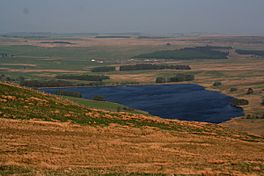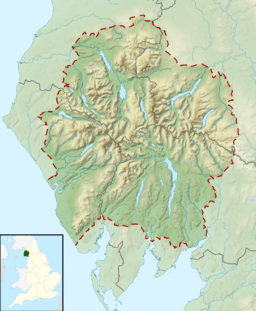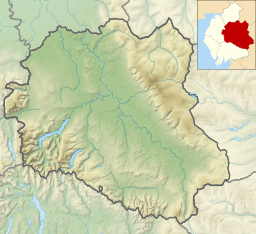Wet Sleddale Reservoir facts for kids
Quick facts for kids Wet Sleddale Reservoir |
|
|---|---|
 |
|
| Location | Shap, Cumbria |
| Coordinates | 54°29′47″N 2°41′44″W / 54.49639°N 2.69556°W |
| Type | reservoir |
| Catchment area | 12.14 km2 (1,214 ha) |
| Basin countries | United Kingdom |
| Surface area | 30.7 ha (76 acres) |
Wet Sleddale Reservoir is a man-made lake found in the beautiful Shap Fells. It is about 4 kilometers (2.5 miles) south of the village of Shap in Cumbria, England. This reservoir is also inside the Lake District National Park.
This lake has a unique triangular shape. It can hold a huge amount of water, about 2,300 million liters! Engineers built a large dam across a stream called Sleddale Beck to create it. The main reason for building this reservoir was to send water to the city of Manchester. The dam itself is very tall, standing 21 meters (69 feet) high, and it stretches for 600 meters (1,969 feet) long.
Contents
How Wet Sleddale Reservoir Works
The water collected in Wet Sleddale Reservoir travels to another big reservoir called Haweswater. Most of this journey happens through long tunnels built underground.
The River Lowther Starts Here
Right at the bottom of the dam, the Sleddale Beck stream flows out and becomes the River Lowther. This river then continues its journey through the landscape.
Visiting the Reservoir
There is a public car park located below the dam. From this car park, you can find a public path. This path lets people walk and explore the south side of the reservoir. A famous walker and writer, Alfred Wainwright, even wrote about a walk from this spot. You can read about it in his book The Outlying Fells of Lakeland, in the chapter called "Wet Sleddale Horseshoe."
Building the Reservoir
The idea to build Wet Sleddale Reservoir came from the Manchester Corporation. They received permission to start this big project under a law called the Haweswater Act, which was passed in 1919. However, the actual construction of the dam and reservoir did not begin until much later, in the 1960s. The entire project was finally finished in 1966.



